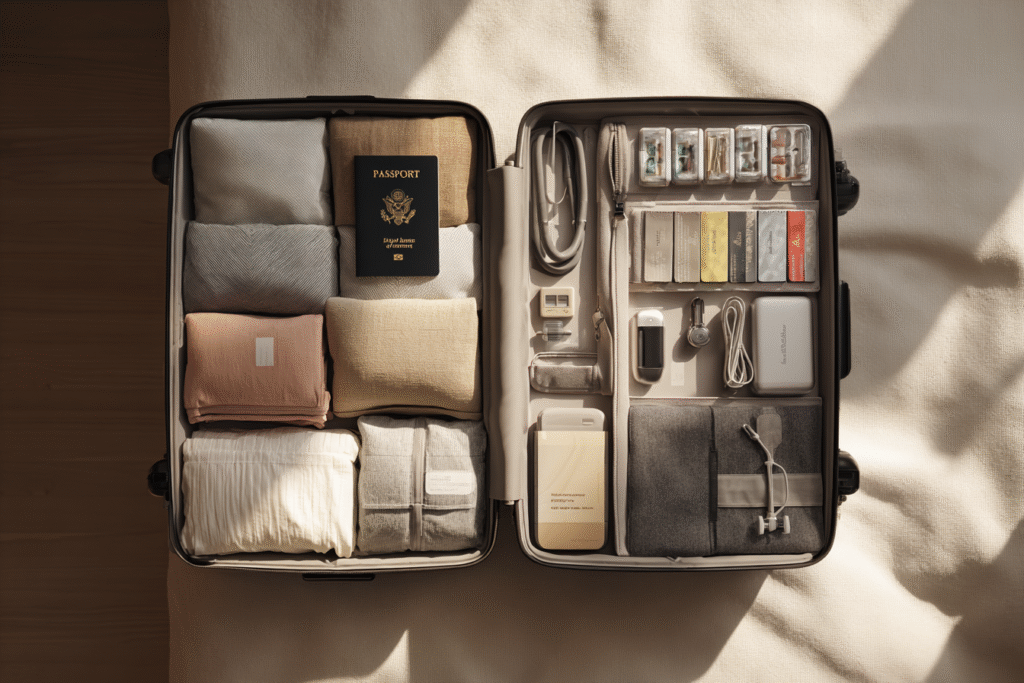Healthcare has become so broken that millions of people now cross borders to find what should be available at home.
Note: This article is for educational and informational purposes only. See full disclaimer at the end.
Picture this: a software engineer from Denver sits in a café in Bangkok, three days after a dental procedure that would have cost him $24,000 in the United States. He paid $4,000 total—flight, hotel, surgery, and a week of recovery on a Thai beach.
Back home, his U.S. dentist reviewed the work and called it “exceptional.” This isn’t a one-off story. It’s a signal.
Medical tourism is expanding fast—growing an estimated 15–25% annually [9]. Analysts project a global market of roughly $278.2 billion in 2025, rising toward $890.4 billion by 2035 [10]. Millions of U.S. residents travel abroad each year, most often to Mexico, Canada, and the Caribbean, for everything from dental work to major surgeries [3].
The better question isn’t why they go, but what their choices reveal about the system they’re leaving behind.

The Math That Sends People Abroad
The math is brutal. In 2022, the United States spent about $12,742 per person on healthcare—more than any peer country—while Switzerland, the second highest, spent $9,044 [4]. Despite this spending, Americans are less healthy and die younger than people in other high-income nations [5].
Price gaps change everything. A single dental implant might run $650 in Mexico versus $5,000 in the U.S. (an 87% savings) [11]. A liver transplant priced near $300,000 in the U.S. may cost about $91,000 in Taiwan [9]. These aren’t back-alley operations.
American doctors know this. “I trained at Johns Hopkins,” says an orthopedic surgeon who now refers patients to colleagues in Costa Rica. “It kills me to admit their outcomes match mine at 20% of the cost. The difference? They spend time practicing medicine. I spend it fighting insurance companies.”
Many of these operations are performed in JCI-accredited hospitals that treat over a million international patients from 190+ countries each year [12]. For complex dental cases, patients routinely save tens of thousands of dollars—$40,000 is not unusual—without compromising standards [13].
And it isn’t only about sticker price. Roughly a quarter of medical tourists travel because their insurance won’t cover the procedure at home [9]. Imagine paying monthly premiums, then discovering that a flight, hotel, time off work, and an overseas surgery still cost less than navigating your domestic benefits. When bankruptcy and a boarding pass sit on the same decision tree, people choose the airplane.
The Quality Paradox
Here’s the part that unsettles the narrative: many people do not trade quality for cost. About half of medical tourists cite access to high-quality care, not only price, as a primary driver [9]. Thailand’s Bumrungrad International Hospital was the first in Asia to earn JCI accreditation and maintains standards comparable to top U.S. hospitals [12].
Turkey has 46 JCI-accredited institutions, including 29 in Istanbul alone [14]. And many Mexican dental clinics follow ADA-level protocols, use FDA-approved materials, and maintain ISO-certified sterilization [15].
Then there’s speed, another quality metric we’ve failed. Long waits at home push about 20% of travelers to seek faster treatment abroad [9]. Even in the U.S. system, where coverage is patchy but nominally private, accessing specialists can involve delays and administrative obstacles that simply don’t exist in many medical tourism hubs.
The result is a direct challenge to the myth that higher U.S. prices guarantee better outcomes. They do not [4].

The Prevention Crisis at Home
Medical tourism is the symptom. Prevention failure is the disease.
We built a system that profits from disease management, not health creation.
The leading drivers of preventable chronic disease—physical inactivity, poor nutrition, tobacco use, and excessive alcohol—account for more than half of preventable deaths in the U.S. [1]. Heart disease kills about 680,981 people a year; cancer 613,352; diabetes 95,190 [6].
Much of this is modifiable with earlier screening and sustained lifestyle support. Yet prevention spending has been estimated at under 3% of total healthcare expenditures [2]. We spend trillions treating what billions might have prevented.
High deductibles and inconsistent coverage nudge people away from routine care until minor issues become major procedures. Today, an estimated 129 million Americans live with at least one chronic condition; 42% live with two or more; 12% with five or more [7].
Those who defer cleanings or screenings for cost reasons eventually need bigger interventions—which they then purchase in Mexico, Colombia, Thailand, Turkey, or elsewhere.
The Human Ledger We Don’t See
Behind the cost-savings headlines are lives, choices, and dignity.
A teacher who “finally fixed my teeth so I can smile again” after traveling to Mexico [13].
She saved for three years, skipping vacations and driving a fifteen-year-old car, just to afford dental work. “I stopped smiling in class photos,” she said. “Students would ask why I covered my mouth when I laughed.”
After Mexico: “I cried when I saw myself smile—really smile—for the first time in five years. My students noticed immediately. One said, ‘Miss, you look happy now.’ That’s when I realized how much my shame had affected them too.” Her $3,500 Mexican procedure would have cost $28,000 at home, nearly her entire annual take-home pay [13].
Parents splitting a college fund to pay for a surgery. Seniors delay care until it becomes critical.
The choices quickly become impossible: a Vietnam veteran chose between his cardiac medication and his wife’s cancer screening. They picked his pills. By the time they could afford her screening, in Tijuana, the window for early intervention had closed.
About 10% of travelers seek holistic or alternative therapies unavailable or unaffordable at home [9], not only for price but for agency—to be treated as a whole person, not just a code in a billing system.
Consider the irony: major insurers will sometimes cover care abroad—GeoBlue, Aetna, and Cigna offer travel health or medical tourism coverage—because it is more cost-effective than paying domestically [16]. When the intermediaries designed to facilitate access become logisticians of exit, the indictment writes itself.
Meanwhile, the rest of the world digitized healthcare. We digitized billing.

Technology, Transparency, and Speed
Part of medical tourism’s rise is simple: it is easier to buy.
Patients can often get firm, upfront prices online, choose among surgeons, view facility credentials, schedule quickly, message teams directly, and access records without a maze of portals. Roughly 30% travel to access newer technology or treatments [9]. The U.S. excels at biomedical research, yet clinical adoption is throttled by regulatory and insurance friction. Abroad, the path from consultation to operating room can be measured in days rather than months.
This clarity and digital ease stand in stark contrast to U.S. opacity, where many patients see the bill only after the procedure. Transparency changes behavior. People act when they can see the road.
What the Exodus Reveals
Follow the money. Administrative costs tied to insurance account for about 15% of excess U.S. health spending; administrative burden on providers contributes another 15% [8].
Nearly one-third of the excess goes to bureaucracy, not health. That money could fund prevention, lower prices, or expand access.
Medical tourism’s growth is a market correction, not a fad. Hospitals like Bumrungrad (Thailand) and groups like Medicana (Turkey) attract patients because they deliver a familiar triad—quality, speed, and price transparency—at a fraction of U.S. costs [10][12][14]. Their success is not an argument to outsource care forever.
It is a mirror showing what our system no longer reliably provides.

A Better Model: Lessons to Import
Countries that win inbound patients share a playbook:
- Transparent, bundled pricing and clear pre-op criteria.
- Streamlined scheduling with minimal administrative drag.
- Strong patient experience and concierge-style coordination.
- Clear credentials and external accreditation (e.g., JCI).
- Integration of prevention with treatment so fewer people need acute interventions later.
Some U.S. providers get it. Oklahoma’s Surgery Center posts all prices online—no insurance, no surprises. Direct Primary Care practices offer unlimited visits for flat monthly fees. These models thrive because they import transparency from abroad while keeping care local. They prove change is possible without boarding passes.
Imagine importing these principles at scale. Publish prices. Make records portable by default. Tie reimbursement to outcomes and preventive milestones. Cover prevention comprehensively to reduce downstream costs. Build patient navigation as a core service, not an afterthought.
Treat health as an investment in human potential, not a billing opportunity.
Before You Go: A Rational Traveler’s Checklist
If you are considering care abroad, treat it like any high-stakes purchase. This is not medical advice; it’s diligence advice.
- Verify credentials (Third-party matters). Look for JCI accreditation and surgeon-specific experience [12][14].
- Demand specifics (Every cost, upfront). Written quotes including surgeon, anesthesia, facility, implants, meds, follow-ups.
- Plan continuity (Before you go). Arrange post-op care at home. Confirm who handles complications.
- Safeguard records (Digital everything). Imaging, operative reports, implant specs, medication lists.
- Ask about infection control (ISO or equivalent). Confirm sterilization standards and protocols [15].
- Understand risks and timing (Buffer days matter). No flying immediately post-op; clear return guidelines.
- Clarify coverage (Call your insurer). Know what’s covered abroad and during return [16].
- Consider the whole cost (Time is money). Include work absence, potential revisions, caregiver support.

The Urgent Call for Change
Every person who boards a plane for basic care is a data point our system should never have generated. Every preventable disease that escalates into a crisis is a policy failure in slow motion. We live in medicine’s most advanced era—genome maps, robotic surgery, rapid vaccines—yet cannot guarantee routine prevention or affordable dental care for the median family. That contradiction is not sustainable.
Medical tourism will keep growing as long as systems prioritize treatment over prevention, complexity over clarity, and profit extraction over health creation. The point is not to celebrate the exodus, but to learn from it. The lesson is simple: when care is transparent, timely, and credibly high-quality, people will find it—if not at home, then somewhere else.
Health tourism is a rational response to an irrational system. But here’s what should terrify policymakers: the doctors are following the patients. Young American physicians now train in Thailand’s hospitals to learn efficiency. Mexican dental schools report rising U.S. applicant numbers. Turkey’s medical programs actively recruit American faculty frustrated with administrative medicine.
When we export our patients, we export our future. When our medical students see better models abroad, they might not come back. The real choice is stark: import the best features of the destinations people trust, or watch as American healthcare—once the world’s gold standard—becomes a cautionary tale taught in foreign medical schools.
The exodus has begun. The question is whether we’ll notice before it becomes an avalanche.
See you in the next insight.
Comprehensive Medical Disclaimer: The insights, frameworks, and recommendations shared in this article are for educational and informational purposes only. They represent a synthesis of research, technology applications, and personal optimization strategies, not medical advice. Individual health needs vary significantly, and what works for one person may not be appropriate for another. Always consult with qualified healthcare professionals before making any significant changes to your lifestyle, nutrition, exercise routine, supplement regimen, or medical treatments. This content does not replace professional medical diagnosis, treatment, or care. If you have specific health concerns or conditions, seek guidance from licensed healthcare practitioners familiar with your individual circumstances.
References
The references below are organized by study type. Peer-reviewed research provides the primary evidence base, while systematic reviews synthesize findings. Peer-Reviewed / Academic Sources- [1] National Institutes of Health (2024). The Burden of Chronic Disease – Leading risk factors account for over 50% of preventable deaths. PMC. https://pmc.ncbi.nlm.nih.gov/articles/PMC10830426/
- [2] American Heart Association (2004). Preventing Cancer, Cardiovascular Disease, and Diabetes – Two-thirds of deaths from these conditions. Circulation. https://www.ahajournals.org/doi/10.1161/01.cir.0000133321.00456.00
- [3] Centers for Disease Control and Prevention (2025). Medical Tourism surveillance data and safety guidelines. CDC Yellow Book. https://www.cdc.gov/yellow-book/hcp/health-care-abroad/medical-tourism.html
- [4] Peter G. Peterson Foundation (2025). How Does the U.S. Healthcare System Compare to Other Countries? – $12,742 per capita spending. https://www.pgpf.org/article/how-does-the-us-healthcare-system-compare-to-other-countries/
- [5] Commonwealth Fund (2023). U.S. Health Care from a Global Perspective – 18% of GDP on healthcare with worse outcomes. https://www.commonwealthfund.org/publications/issue-briefs/2023/jan/us-health-care-global-perspective-2022
- [6] CDC National Center for Health Statistics (2024). Leading Causes of Death – Heart disease: 680,981, Cancer: 613,352 deaths. https://www.cdc.gov/nchs/fastats/leading-causes-of-death.htm
- [7] CDC Preventing Chronic Disease (2024). Chronic Disease Prevalence – 129 million Americans with chronic disease. https://www.cdc.gov/pcd/issues/2024/23_0267.htm
- [8] Commonwealth Fund (2023). High U.S. Health Care Spending: Where Is It All Going? – Administrative costs analysis. https://www.commonwealthfund.org/publications/issue-briefs/2023/oct/high-us-health-care-spending-where-is-it-all-going
- [9] Medical Tourism Statistics (2025). Medical tourism industry growing 15-25% annually with 40-80% cost savings motivating patients. Medical Tourism Statistics and Facts. https://media.market.us/medical-tourism-statistics/
- [10] Future Market Insights (2025). Medical Tourism Market to reach $278.2 billion in 2025, growing to $890.4 billion by 2035. https://www.futuremarketinsights.com/reports/medical-tourism-market
- [11] Medical Tourism Co (2025). Dental Work in Mexico: 87% savings on implants, $650 vs $5,000 in US. https://www.medicaltourismco.com/dental-tourism-mexico/
- [12] Konkai Health (2025). Best JCI-accredited International Hospitals in Thailand – Bumrungrad first in Asia with JCI. https://www.konkai.health/hospitals
- [13] Dayo Dental (2024). Mexico Dentist advantages including $40,000 savings on major dental work. https://www.dayodental.com/mexico-dentist-dental-work/
- [14] Hoospital (2024). JCI Accreditation in Turkey – 46 JCI-accredited institutions, 29 in Istanbul. https://www.hoospital.com/blog/what-is-jci-accreditation-which-hospitals-have-jci-accreditation-in-turkey/
- [15] Dental del Rio (2025). Cost of Dental Work in Mexico – Los Algodones serving 6,000+ US patients with ADA-level protocols. https://dentaldelrioalgodones.com/blog/dental-tourism/cost-of-dental-work-in-mexico/
- [16] Academy of General Dentistry (2020). Worth the Trip? Insurance coverage for medical tourism and quality considerations. https://www.agd.org/constituent/news/2020/01/20/worth-the-trip-a-look-at-dental-tourism


